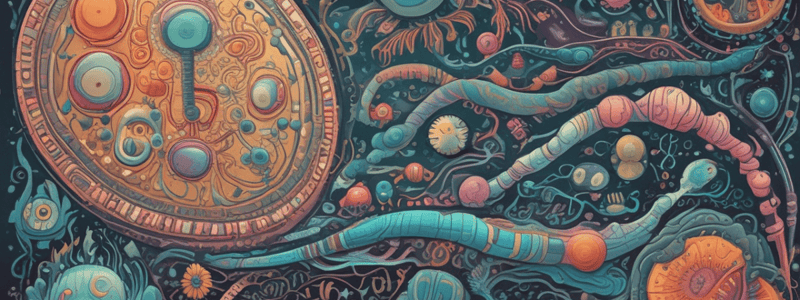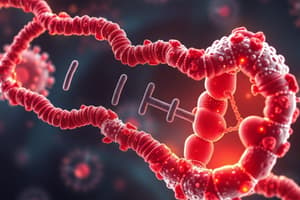Podcast
Questions and Answers
What is the primary function of initiation factor 3 in prokaryotic translation?
What is the primary function of initiation factor 3 in prokaryotic translation?
- Preventing the binding of the 50S subunit to the 30S subunit before initiation is complete (correct)
- Recognition of the Shine-Dalgarno sequence
- Binding of fMet-tRNA to the start codon
- Facilitating the binding of aminoacyl-tRNA to the 30S subunit
Which of the following mechanisms is NOT a way to regulate MRNA stability?
Which of the following mechanisms is NOT a way to regulate MRNA stability?
- RNA-binding proteins
- 5' and 3' untranslated regions (UTRs)
- Secondary structure of MRNA
- MRNA splicing (correct)
What is the mechanism of action of the antibiotic chloramphenicol?
What is the mechanism of action of the antibiotic chloramphenicol?
- Inhibiting the binding of aminoacyl-tRNA to the 30S subunit
- Interfering with the initiation of translation
- Mimicking aminoacyl-tRNA and prematurely terminating protein synthesis
- Inhibiting peptidyl transferase activity (correct)
Which of the following is an example of translational coupling?
Which of the following is an example of translational coupling?
What is the function of the Shine-Dalgarno sequence in prokaryotic translation?
What is the function of the Shine-Dalgarno sequence in prokaryotic translation?
Which of the following is NOT a mechanism of MRNA degradation?
Which of the following is NOT a mechanism of MRNA degradation?
Study Notes
Initiation Factors
- Prokaryotic initiation factors:
- IF1 (initiation factor 1): helps in the assembly of the initiation complex
- IF2 (initiation factor 2): binds to the 30S subunit and facilitates binding of fMet-tRNA
- IF3 (initiation factor 3): prevents the binding of the 50S subunit to the 30S subunit before initiation is complete
- Roles of initiation factors:
- Recognition of the Shine-Dalgarno sequence
- Binding of fMet-tRNA to the start codon
- Formation of the initiation complex
MRNA Stability
- MRNA stability affects translation:
- MRNA degradation rates influence the amount of protein synthesized
- MRNA stability is regulated by:
- RNA-binding proteins
- 5' and 3' untranslated regions (UTRs)
- Secondary structure of MRNA
- Mechanisms of MRNA degradation:
- Exoribonucleases (e.g., RNase II)
- Endoribonucleases (e.g., RNase E)
Protein Synthesis Inhibitors
- Antibiotics that inhibit prokaryotic translation:
- Aminoglycosides (e.g., streptomycin): interfere with initiation and misread MRNA
- Tetracyclines: bind to the 30S subunit and prevent aminoacyl-tRNA binding
- Macrolides (e.g., erythromycin): inhibit translocation of the ribosome
- Other inhibitors:
- Chloramphenicol: inhibits peptidyl transferase activity
- Puromycin: mimics aminoacyl-tRNA and prematurely terminates protein synthesis
Translational Coupling
- Definition: the process by which the translation of one gene is dependent on the translation of another gene
- Mechanisms:
- Overlapping genes: genes that share the same MRNA sequence
- Polycistronic MRNAs: single MRNA encoding multiple genes
- Regulatory elements: sequences that regulate translation initiation
Ribosome Binding
- Ribosome binding sites (RBS):
- Shine-Dalgarno sequence: a conserved sequence upstream of the start codon
- SD-augmented RBS: additional sequences that enhance ribosome binding
- Mechanism of ribosome binding:
- The 30S subunit binds to the RBS
- The 50S subunit binds to the 30S subunit, forming the 70S initiation complex
Studying That Suits You
Use AI to generate personalized quizzes and flashcards to suit your learning preferences.
Description
Learn about the initiation factors, mRNA stability, protein synthesis inhibitors, translational coupling, and ribosome binding in prokaryotic translation. Understand the mechanisms and processes involved in this complex process.




